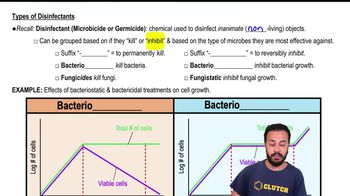Here are the essential concepts you must grasp in order to answer the question correctly.
Water Treatment Processes
Water treatment involves a series of processes designed to remove contaminants and make water safe for drinking. Key stages include coagulation, sedimentation, filtration, and disinfection. Each step plays a crucial role in reducing pollutants and pathogens, ensuring the water meets health standards.
Recommended video:
Coagulation and Flocculation
Coagulation is the process of adding chemicals, such as alum, to water to bind small particles together into larger aggregates called flocs. This is followed by flocculation, where gentle mixing encourages the formation of these larger particles, which can then be removed more easily during sedimentation.
Disinfection Methods
Disinfection is a critical step in water treatment that aims to eliminate harmful microorganisms. Common methods include chlorination, ultraviolet (UV) light treatment, and ozonation. Each method has its advantages and limitations, and the choice depends on factors like water quality and regulatory requirements.
Recommended video:
 Verified step by step guidance
Verified step by step guidance Verified Solution
Verified Solution


 1:54m
1:54m